Page 1
2
3
4
5
6
7
8
9
10
11
12

Topkapi Palace seen from Galata Bridge |
Friday, 14 April. This was our
last full day in Istanbul, and we had decided to spend most of it at the Topkapi
Palace, also in the Sultanahmet district. A dolmus took us within a couple
blocks of the entrance. As we started walking toward it, a young man fell in
with us, speaking limited English. Kemal said he was a professional guide and
offered to take us through Topkapi for a very reasonable price. Although we were
a little suspicious, we finally agreed.
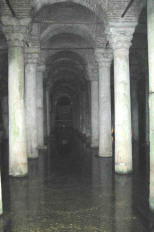
A few of the 336 columns |

Brick ceiling above column |
|
Almost immediately, he diverted us toward a dilapidated
doorway leading to a long flight of stone steps. We really couldn’t understand what he wanted us
to see, but he kept saying “water.” Reluctantly, we followed him down about 50 steps, lighted by
only an occasional bare bulb. Finally at the bottom, we could make out hundreds of tall (30 feet)
marble columns standing in a couple feet of water and supporting a vaulted brick roof. We found
out later (not from Kemal) that this was the Yerebatan Cistern, originally built by Constantine the
Great and enlarged by Justinian in the 6th century. The cistern had been largely neglected after the
fall of the Byzantine Empire in 1453, and was now just a muddy (but still impressive) ruin.
(The cistern was cleaned up, renovated, and illuminated in 1987 and has since become a major
tourist attraction. When we saw it, though, it was not open to the public. We got in only because
Kemal knew the lock on the old door was broken. The cistern measures 215 by 430 feet. It has
336 columns, 12 rows with 28 columns each.)

Gate of Salutation into Topkapi Palace
|
Seeing this impressive cistern that was not even mentioned in our guide book gave us new
confidence in Kemal. That was quickly dispelled, though, when we reached to entrance gate to
Topkapi. Although we really couldn’t understand exactly what was said, it was apparent that
Kemal had identified himself as our guide and wanted free or discounted admission to the Palace.
The ticket seller not only refused him, but loudly scolded him, apparently for trying to pass
himself off as a guide. Although it was obvious to us that Kemal had never
before tried to enter Topkapi as a guide, we finally paid for his ticket as well as our own.
It soon became apparent that Kemal was not at all familiar with the sights of Topkapi. Most of the
time we couldn’t understand him, and when we did, his explanations were invariably contradicted
by our guide book. We finally ignored him and he just followed us around.
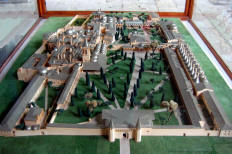
Model of Topkapi Palace |
Construction of what is now known as Topkapi Palace began soon after Sultan Mehmet II (the
Conqueror) captured Istanbul in 1453. He had the first buildings constructed on the present site.
For the next four centuries, Topkapi Palace was the principal residence of all the Ottoman sultans.
During this time, the palace complex underwent constant evolution. Buildings disappeared;
buildings were added. Topkapi was abandoned in favor of a new palace on the Bosphorus in 1856
and fell into disrepair. After the establishment of the Turkish Republic in 1923, Topkapi was
renovated and turned into a museum.
As we came through the gate, we were in a large park-like courtyard. (It's
called the “Second Court.” The large
public park outside the gate is the "First Court" or Court of the Janissaries.) The
harem, which was supposed to be the most interesting part, was to our left front,
and we decided
to save that for last. So we started down the right side. We quickly browsed the extensive
kitchens which now housed displays of china and silver, not really what we'd
come to Topkapi to see. We passed through the Gate of Felicity
and into the Third Court, the area where the sultans
had lived. Just inside was a small building (the Throne Room) where the sultans received
ambassadors and dignitaries.

Gate of Felicity |

Chimneys on the kitchens |
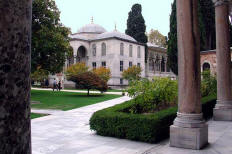
The Throne Room |
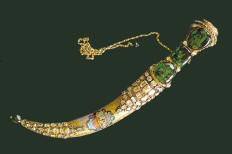
Jeweled "Topkapi dagger" in the Treasury
|
Off to the right was the Imperial Wardrobe, with a collection of the
richly decorated robes (kaftans) and baggy pants worn by the various sultans. Kemal directed us to the Treasury
(housed in the Palace's oldest building),
where an 86 carat diamond, many other jewels and jeweled objects, candlesticks,
and ceremonial thrones were displayed. We even saw the jeweled dagger (1746)
that was the target of the thieves in the 1964 movie "Topkapi".
We took a quick look into the Fourth Court. There were some elaborate
buildings that Kemal
insisted were not open to the public. He
then led us to the Chamber of the Holy Relics that he said housed Mohammed’s cloak, hair,
and other relics. We didn't want to offend Kemal, but we really weren't
particularly interested in Islamic relics. We also were eager to get to the
Harem. Before we had to make a final decision, Kemal discovered that the Chamber
wasn’t open anyway.
Finally it was time to visit the Harem. The Harem contained more than 300 rooms, but also many
courtyards, gardens, staircases, and passageways. In addition to the chambers for the women,
there were quarters for the sultans, the many princes, their foreign teachers, and the Black
Eunuchs who guarded the women.
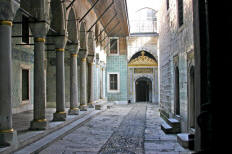
Entrance to the Harem |
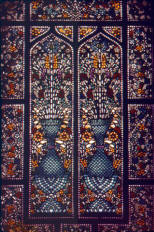
Stained glass window |

Imperial Hall (Salon) |
Relatively few of the rooms were open to the public, maybe 20 or
30. (We didn’t count and it was sometimes hard to tell where one room ended and
another began.) There were guards in every room, but no guides to explain
anything. I
tried to follow in our guide book, and Kemal tried to explain something every once in a while.
(His explanations invariable were inconsistent with the guide book.) Much of the time we had no
idea what we were looking at. It really didn’t matter, though, because we were just enjoying the
beauty of the rooms. It may mean, though, that some of our slides are mislabeled
or out of order.

Windows in Sultan's bedroom |
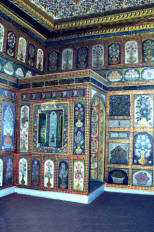
Library of Ahmet III (1705) |
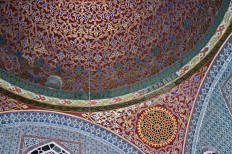
Domed ceiling in Sultan's bedroom |

Terrace leading to Circumcision Room |
|
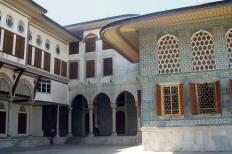
Courtyard of the Favorites
|

Imperial Council Chamber |
We left the Harem and walked back through the Second Court, passing perhaps the
most ornately decorated building we had seen, the Imperial Council Chamber. By this time we were “toured out”
and just couldn’t absorb any more. It was also
after 14:00, and we hadn’t had any lunch.
First, though, we had to get rid of Kemal. In spite of his
obvious lack of qualifications as a guide, we paid him what we had agreed, but let him know we
weren’t pleased with his services. When we got to a commercial area, we went into the first
restaurant we found. We both ordered the shrimp special, and we each got one shrimp. However,
it was at least five inches long and, served butterflied, almost filled a small plate. It was more than
enough.
We found the dolmus to Taksim Square and went back to our hotel to rest and begin packing for
tomorrow’s departure. We had dinner at the hotel.
Page 1
2
3
4
5
6
7
8
9
10
11
12
Home
Copyright 2000-2024 DarrellPeck.com All rights
reserved.
|
| | |